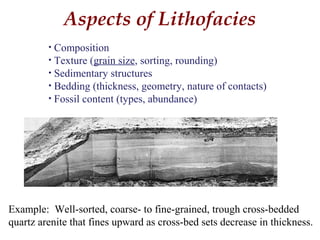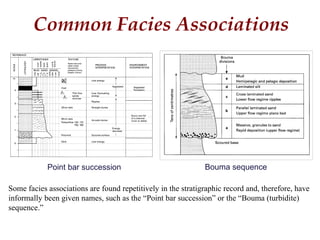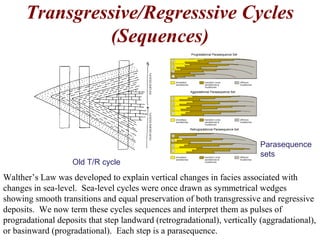Facies Models
- 1. Sedimentary Facies (Lithofacies) A lithofacies is a body of sediment/rock distinguished by a specified combination of characteristics (composition, texture, sedimentary structures) related to a specific set of physical, biological, and chemical processes.
- 2. Aspects of Lithofacies • Composition • Texture (grain size, sorting, rounding) • Sedimentary structures • Bedding (thickness, geometry, nature of contacts) • Fossil content (types, abundance) Example: Well-sorted, coarse- to fine-grained, trough cross-bedded quartz arenite that fines upward as cross-bed sets decrease in thickness.
- 3. Sedimentary Facies & Depositional Environments The unique characteristics of a lithofacies represent deposition under the very specific conditions of a single environment. For example, the facies of the previous slide suggests flood stage deposition on a point bar of a meandering stream.
- 4. Separation of data (facies) and interpretation (environment) In science, it is critical to distinguish between data (what’s there - lithofacies) and interpretations (how you think it got there – depositional environment). There is not complete agreement upon use of the term facies. Many use it in conjuction with the interpreted environment (e.g. point bar facies). I consider this as a misuse of the term. Data Interpretation
- 5. Lithofacies Codes Some attempts have been made to devise abbreviations for commonly found lithofacies. These typically employ a capitol letter for the major clast size (i.e. G for gravel, S for sand, and F for fine- grained) followed by lower case letters denoting the major structure (i.e. t for trough cross-bedding and p for planar cross-bedding).
- 6. Facies Associations/Assemblages Facies association: a collection of multiple, genetically-related facies formed within a single depositional system. Example: Non-stratified gravel overlain by well- sorted coarse- to fine- grained, trough cross- bedded sand that fines upward as cross-bed sets decrease in thickness overlain by ripple-bedded sandstone. Succession grades laterally to laminated mudstone that contains thin lenses of sandstone.
- 7. Common Facies Associations Some facies associations are found repetitively in the stratigraphic record and, therefore, have informally been given names, such as the “Point bar succession” or the “Bouma (turbidite) sequence.” Point bar succession Bouma sequence
- 8. Facies Associations (Architectural Elements) of Miall Miall formalized facies associations for fluvial systems. These are used widely (but not universally) with modification.
- 9. Facies Associations and Depositional Systems A depositional system consists of genetically-related, contemporaneous depositional environments. Vertical changes in facies associations can reflect either lateral migration of environments within a system or fluctuation in base-level.
- 10. Facies Models/Architecture Facies models are based on facies associations and are designed to show the three-dimensional relationships (architecture) between individual facies (architectural elements) for a depositional system. Models can be taylored to a specific stratigraphic unit or can be generalized to show an “average” of characteristics for a “typical” depositional system. Generalized model for a “typical” meandering stream system
- 11. Subsurface Facies Models Subsurface facies models have the same components as those based on outcrop but, typically, with less detail; although, recent advances in 3-D seismic is narrowing that gap. Fluvial model based on well logs Fluvial model based on 3-D seismic
- 12. Architecture Element Analysis Architectural element analysis consists of making photomosaics of outcrops and mapping individual elements (facies).
- 13. Systems Tracts A systems tract consists of contemporaneous depositional systems. Vertical changes in systems tracts reflects changes in sea-level.
- 14. Vertical Facies Successions Facies successions occur on three scales: 1) facies assemblage associated with a depositional system, 2) larger-scale stacking of adjacent systems within a systems tract; and 3) long-term basin fill successions. Idealized meandering stream vertical profile Idealized deltaic succession Stacked Cretaceous systems tracts in the Book Cliffs
- 15. Walther’s Law WaltherWalther’s Law (1894) states that facies found superimposed on one’s Law (1894) states that facies found superimposed on one another and not separated by an unconformity, must have beenanother and not separated by an unconformity, must have been deposited adjacent to each other at a given point in timedeposited adjacent to each other at a given point in time Floodplain Levee Point Bar Photo by W. W. Little
- 16. Walther’s Law & Systems Tracts Most systems tracts are preserved in the stratigraphic record as progradational successions. Prograding beach Prograding tidal flat
- 18. Transgressive/Regresssive Cycles (Sequences) Walther’s Law was developed to explain vertical changes in facies associated with changes in sea-level. Sea-level cycles were once drawn as symmetrical wedges showing smooth transitions and equal preservation of both transgressive and regressive deposits. We now term these cycles sequences and interpret them as pulses of progradational deposits that step landward (retrogradational), vertically (aggradational), or basinward (progradational). Each step is a parasequence. Old T/R cycle Parasequence sets


















